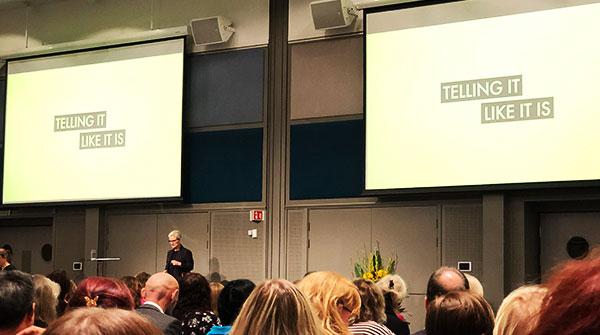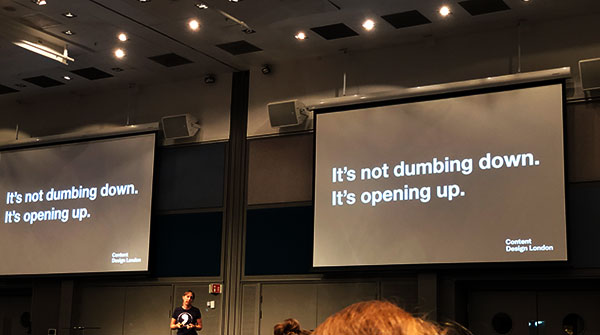Readable headed to the most important plain language event of the year, joining around 400 attendees and over 100 speakers from 25 countries. What does PLAIN stand for and how did the conference remind us of our core values?
What is PLAIN?
Plain Language Association International (PLAIN) is a nonprofit dedicated to growing a network of plain language advocates and practitioners worldwide.
Their aims include increasing public awareness of plain language and helping people understand the key principles, hosting networking events and conferences for members and promoting research.
They also set standards for plain language use and promote a comprehensive approach which considers audience and purpose, structure, design, expression and evaluation.
What is PLAIN 2019?
PLAIN 2019 was a conference held in September. It brought together over 100 speakers from 25 countries to share their insights about plain language and its benefits to governments and private businesses alike.
This year it was held in Oslo, Norway.
How can plain language benefit me?
As we learned at the plain language conference, plain language is for everyone. Readability is a key principle of plain language because it ensures your writing is appropriate for the general public.
A common argument against readability is that it’s “dumbing things down”. But it’s not dumbing anything down. It actually takes a lot more skill to write plainly and effectively than to cloak your writing in jargon. Plain language is about opening up your content. This makes it easy to understand so that you don’t alienate your audience.
PLAIN 2019: a roundup
The pre-conference was a warm welcome to Oslo, and kicked off to a good start. We learned about Norway’s 10-year-long journey with government-supported plain language. One of the key milestones of this was the implementation of plain language in law education. The pre-conference presentations also set the tone for the weight of plain language as a key part of any democratic society.
A resounding message from these pre-conference presentations was that clear language translates as clear action in communication - and that plain language and readability is of utmost importance in the public sector.
Joining 400 other participants, we arrived at the conference day 1 eager to learn about how other organizations use plain language to their advantage.
Plain language and democracy
The most powerful case study discussed was by Christine Smith of Clearspace, New Zealand. She helped to craft the New Zealand Labour Party’s Policy Platform. She discussed Jacinda Ardern’s powerful “you are us” speech following the Christchurch shooting. It was inspiring to learn how Ardern and the New Zealand Labour Party use plain language to encourage transparency and trust.
It was very timely that we attended this conference just after the news that it was unlawful for our PM Boris Johnson to suspend parliament. It was refreshing to see that by using plain language in politics, other governments can achieve great results simply by telling it like it is.
It also highlighted the relevance of plain language to speech writing.

Following this was a plenary session which expanded on these themes of democracy and inclusion, with accessibility being a major factor.
We already knew that the principles of readability are key for good communication. What the case studies discussed taught us is the very real impact that clear communication has on people’s daily lives. True inclusion and diversity can only happen if everybody is on the same page.
Of the poster sessions following this, perhaps the most interesting was Dr Mialisa Moline and Matthew Philion’s ‘teaching the transition from academic-speak to plain language’. This is a course they offer to students transitioning to business writing.
This poster session particularly resonated with me as a, as I term it, ‘recovering academic’. Especially in disciplines that encourage overcomplication, it’s important for students starting work to understand how to communicate efficiently.
Plain language saves time and money
Although there were so many great concurrent sessions to choose from in the afternoon, I attended the ‘plain language pays off’ session. Marianne Holt Holgersen of The KLP group discussed how they personalized the need for plain language to completely change the culture in their workplace, as well as improve their communications. This presentation stuck out the most for me because of the power of plain language to transform company culture.
Their "Save Kåre" project was a fantastic example of how to change the culture in an organization to always keep the customer in mind. By doing this, they also saved a lot of time and money. This reinforces our view that it’s in every company’s best interests to have great readability. I will certainly be inspired by their approach when I’m writing future responses to customers or writing content. I’ll be asking myself, “Would Kåre understand this?”
After an info-packed conference day 1, we joined the fascinating historic guided tour around Oslo, enjoyed some seafood at the Grand Cafe, and made sure we were well-rested for day 2.
There is no excuse not to use plain language
Sarah Richards, founder of Content Design London, didn’t mince words with her presentation. She made no excuses for people using over-complicated language. Reiterating the points about diversity and inclusion we’d heard throughout the conference, she pointed out that not making your content accessible for everybody is discriminatory.
She also condemned the attitude some have to simplifying their content and the superior attitude that comes with this, as she has a “real problem with arrogance”. We loved her candid approach which is so in keeping with the principles of plain language and telling it like it is… kudos to Sarah for practising what she preaches.

Readability trailblazer Prof Joseph Kimble also joined for the plenary session on saving time and money. With his many years of experience in the field, he made a strong case for plain language in business, government and law.
Joe Kimble has more than 20 years of experience writing about the benefits of readability. He hit on the key points he’s been making and continues to make throughout his career, highlighting case studies with savings running into millions of dollars.
Dr Neil James of Australia’s Plain English Foundation then brought PLAIN 2019 to a close with his keynote speech ‘the future is clear’. Citing the US Plain Language Act of 2008 passed by Barack Obama, he reflected on how far we’ve come, and how far we still have to go.
See you in 2021
We don’t know the location of the next PLAIN conference - all we know is that we’ll be there. The three days we spent in Oslo were filled with so many key insights about readability’s value in both government and business.
We met passionate and likeminded people who are making a real difference in their communities. We came out of the experience with fresh new ideas about what we can do as advocates and how we can further develop Readable.


